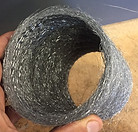Zander Slavitz
Motorcycle Muffler Venturi CFD
Napkin Sketch to Product
Introduction
Background
A motorcycle muffler is used to:
-
Funnel exhaust to reduce engine sound
-
Manage temperature of engine combustion
-
Expel burnt fuel
-
Manage back pressure to ensure engine can function properly
-
Control vibration of motorcycle
A motorcycle would attain maximum torque and power if engine combustion released exhaust to ambient immediately. If a venturi helped increase exit speed of fluid flow, engine efficiency should increase.
Research Goal
Show benefit of patented device by investigating the effect of inlet flow rate on pressure, velocity, and flow patterns around venturi and at end of muffler.
Research Materials

Outer Muffler
Baffle
End Cap
Venturi
Venturi Housing
Sound Attenuation Tube
Stand-Off

Outer Muffler

Sound Attenuation Tube

Outer Muffler & End Cap



Venturi with Stand-Offs
Baffle with Venturi & Stand-Offs
End Cap
Research Questions
1) What is the effect of increasing the size and/or number of small holes around venturi throat?
2) What is the effect of the length of the diverging part of the venturi on airflow through educator holes and around the venturi housing?
3) What is the effect of the length of the non-perforated section on the baffle on the pressure and velocity between the venturi and baffle tube?
Methods
SolidWorks CFD Analysis:
-
Fluid: Air
-
Mesh: Refined mesh applied around and inside venturi
-
Initial Velocity: 100 - 600 CFM
-
Exit Pressure: 101.325 kPa
Results
*Due to patent intellectual property, I have been given permission to only display velocity results at regions of interest in the motorcycle muffler at one flow rate

1
2
3

4
5
6
300 CFM

